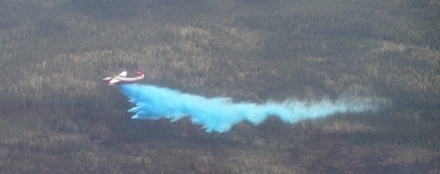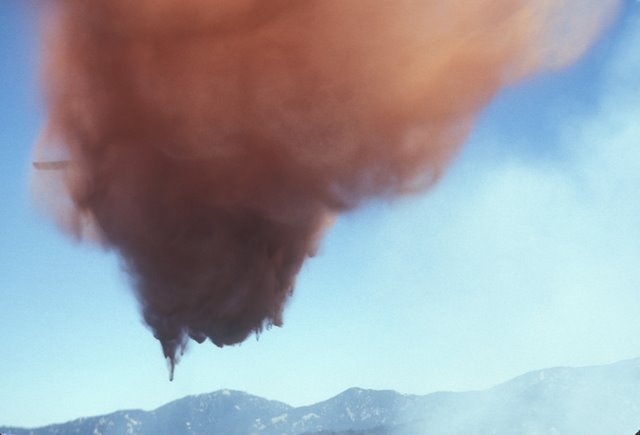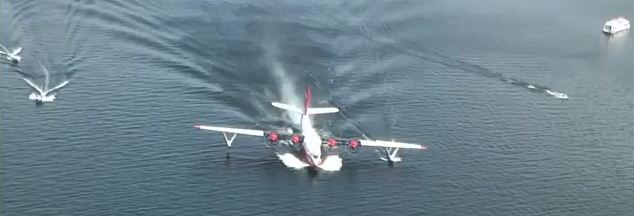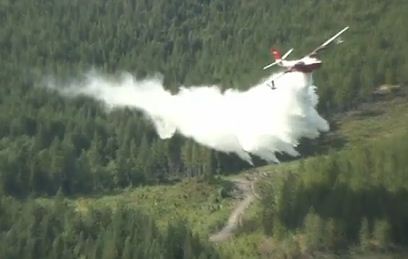
Update at 9:30 a.m. MT, June 9, 2011
KPHO’s report about the 747 being activated for the Arizona fires, even though it was picked up by numerous web sites and spread around the internet like, uh, wildfire, is incorrect. Wildfire Today talked with Steven Daniels who leads the 747 Supertanker program at Evergreen and he said the 747 is not being dispatched. As we reported yesterday below, the U.S. Forest Service is not interested in agreeing to an exclusive use contract with Evergreen or 10 Tanker Air Carrier for their 747 or the DC-10 air tankers.
However, Rick Hatton, the CEO of 10 Tanker Air Carrier, told Wildfire Today Thursday that one of their DC-10 Very Large Air Tankers, Tanker 911, is en route to Phoenix Mesa Gateway airport now to work on the fires. They still do not have any kind of a contract with the USFS, so they are being activated through a Call When Needed contract the company has with CalFire. This is the same methodology used when the DC-10 was used in Texas a few weeks ago.
CalFire explained the deployment of the DC-10 on their website:
Victorville – One of the nation’s only DC-10 Very Large Airtankers has been deployed from California to assist in fighting the raging wildland fire in Arizona. The request was made yesterday by the United States Forest Service. The aircraft, Tanker 911, took off this morning to help in Arizona from its base in Victorville.
The Forest Service is accessing the DC-10 through a call when needed contract CAL FIRE has with 10 Tanker, the company that operates the only two DC-10 Very Large Airtankers in the world. During peak fire season, CAL FIRE has an exclusive use contract with 10 Tanker to enhance its aerial firefighting fleet.
Update at 11:54 p.m. MT, June 8, 2011
KPHO is reporting that “fire officials” said late Wednesday that they are bringing in the Evergreen 747 Supertanker to assist with the fires. It should arrive Thursday. The aircraft has been sitting at Tucson, so it will be a short 20-25 minute flight to the Wallow fire, if that is where it will be used.
=======================
If you are wondering why you have not heard anything about the Very Large Air Tankers (VLAT) like the 747 or DC-10 being used in Arizona, it’s because they are not working on any fires in the United States. It is interesting that in the last couple of months both Mexico and Canada have contracted to use VLATs, with the 747 working in Mexico and the Martin Mars working in Mexico and Canada. A DC-10 is currently beginning an assignment in Canada. Two VLATs are being used in Canada right now, and another two are sitting at airports in Arizona and California waiting for the phone to ring.
We try not to be an armchair Incident Commander and second guess from hundreds of miles away the firefighters that are at the scene of a fire, breathing smoke and making decisions based on actual facts, so until we hear otherwise, we’ll give the firefighting agencies the benefit of the doubt and consider that maybe with the 15 to 18 large air tankers (conventional, not VLAT) that are presently or soon to be on contract and available, that there are plenty of them to deal with the very extremely large fires in Arizona, the multiple fires in Colorado, and the ones in Alaska. And the large DC-10s and the 747 may or may not be suitable for working in those terrain conditions.
One issue is that some large air tankers are not scheduled to come on contract until June 10. So, in a couple of days one or more additional conventional air tankers will be available.
Another issue is that this year the U.S. Forest Service is not interested in signing Exclusive Use contracts with the VLAT companies, which would put the aircraft on contract to be on standby every day for a period of months and be guaranteed payment for availability. The USFS is offering Call When Needed (CWN) contracts, whereby the agency would only pay for actual use on a fire, or for specific standby during a period of high fire activity.
It is going to be difficult for operators of VLATs to remain in business if the aircraft are only used on rare occasions. With only 18 or 19 large air tankers on exclusive use contracts, versus the 44 we had in 2002, one might assume that the federal government would be seeking ways to have more air tankers available. And one would be wrong if they made that assumption.
Evergreen’s 747 Supertanker
We talked with Steven Daniels who leads the Supertanker program at Evergreen. Their 747, Tanker 979, holds 20,000 gallons, about seven times more than a conventional large air tanker. He told us that presently they have no contract with the U.S. Forest Service. Daniels said the USFS offered them a CWN contract, meaning that most of the fire season an expensive piece of equipment would sit without receiving any compensation. Evergreen would like to get an Exclusive Use contract, but the USFS is not interested in that concept.
Daniels told us that he received a phone call from the White House recently asking why the Supertanker was not being used in Arizona. He told them that it is available, sitting at Tucson, Arizona, but there is no contract with the USFS.
DC-10
The 10 Tanker Air Carrier company has two DC-10 VLATs which have performed over 350 missions on 50 fires in their four years of operations, carrying up to 11,000 gallons of retardant, about four times more than a conventional large air tanker. One of them, Tanker 910, flew to Alberta, Canada yesterday and will begin working on fires out of Cold Bay today. The other, Tanker 911, is sitting at their base in Victorville, California, available for an assignment. Rick Hatton, the CEO of the company, told Wildfire Today that at this time neither of the DC-10s is on contract with the USFS. As with the 747, the USFS is not interested in an Exclusive Use contract with 10 Tanker Air Carrier, and a CWN contract is winding its way through the federal government contracting offices now. CalFire will have one of the DC-10s on Exclusive Use contract later this year. Hatton, like Daniels of Evergreen, would also like to have an Exclusive Use contract with the USFS, but at this time it is not in the cards.
Martin Mars
Right now the Martin Mars is also working on fires in Canada, flying out of Gregoire Lake near Fort McMurray. The company has a contract with the British Columbia government, but none with the USFS or any other agency in the United States. It can carry up to 7,200 gallons and can scoop water from a lake and mix gel or foam concentrate into it from on-board tanks.




